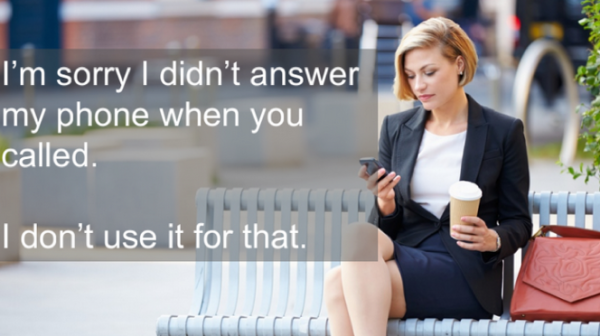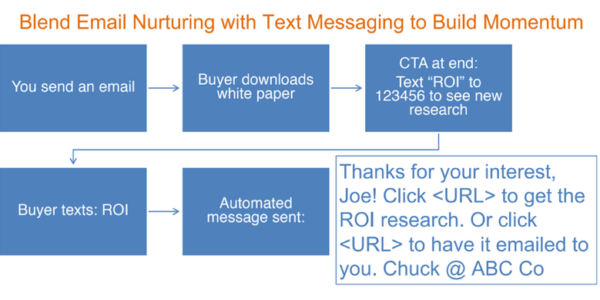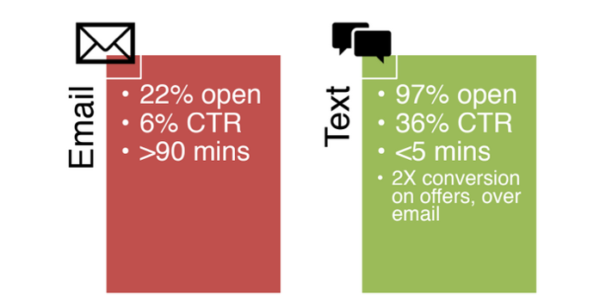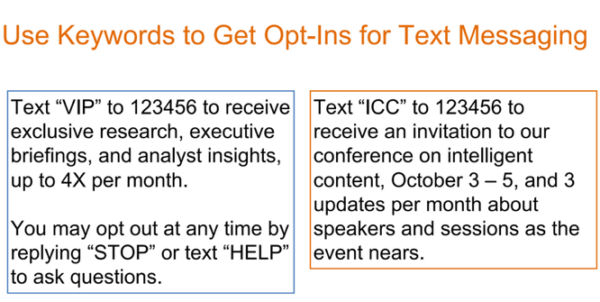13 Reasons Why You Should Consider Text-Based Marketing

The urgency and intimacy of text-based marketing make it attractive to businesses. But it’s those same qualities that make SMS communication from a brand especially risky.
However, when done strategically, respectfully, and in a contextually relevant way, Ardath Albee, CEO of Marketing Interactions Inc., says the profitable benefits of SMS marketing easily supersede the most common pitfalls of this unique channel.
SMS marketing benefits easily supersede the pitfalls, says @Ardath421. #intelcontent
Click To Tweet
She presented on the topic at the Intelligent Content Conference this year, Automation Isn’t Just for Email: Why Messaging Can Be the Conversation that Counts.
Before acknowledging and addressing the sometimes disastrous risks of SMS (short message service) and MMS (multimedia messaging service) marketing, Ardath shares 13 reasons the medium can (and often does) outperform other channels and automated tactics.
1. Personal devices are more personal than ever
“People are looking at their smartphones out of boredom,” Ardath points out. Nearly a third of millennials globally check their phone screen at least once every five minutes without being prompted by an alert or notification, according to KPMG’s 2017 Me, My Life, My Wallet Report.
2. Texting is the most-used mobile device feature
The only thing more personal than the phone itself is the standard messaging app, where users spend more time than anywhere else on their device. Ninety-seven percent of all smartphone users text their contacts at least weekly.
3. 85% of mobile device users prefer a text from businesses over phone calls or emails
Turns out, when given the choice, customers would rather engage via SMS messaging than by way of voice or email — a surprising fact given what many marketers expect.
85% of mobile users prefer SMS messages over emails or calls from businesses via @ATT #research.
Click To Tweet

4. B2B brands hesitate to integrate texting, creating a low-competition vacuum of opportunity
Ardath explains that your business clients are individual consumers who receive text marketing from B2C brands during off hours (think puppy food, car insurance, or local restaurant deals). Why, then, wouldn’t they expect professional vendors to target them with productivity tools or services throughout the workday?
5. Users don’t need to download a new app or learn to navigate a new interface
These days, each new channel comes with a learning curve for both brand and user. Texting doesn’t require any new skills.
6. Users don’t even need a smartphone or internet access
Whether by choice or necessity, some people carry simpler mobile phones. They don’t (or can’t) consume web-based data when away from Wi-Fi. They can’t consume infographics, streaming audio, social updates, and blog posts, but they can receive your texts.
7. Text messaging can be used at every stage of the buyer’s journey
To visualize this, Ardath encourages marketers to think about mobile messaging from different perspectives – marketing, sales, service, etc. “You could use text messaging to engage at every stage of the buying process, which becomes more and more important when we’re challenged to create better and better customer experiences across our entire customer relationships,” she says.
8. Texts are interactive
Users opt in to initiate the conversations. Then, keywords keep the interaction dynamic. Receiving a text, opening it, and considering a response puts users in an active role.
9. SMS marketing is one to one
Often, marketers time campaigns in hopes of serving audiences right around the time they need that touch. With text messaging, the customer decides when to interact. This takes all guesswork out of the “right people at the right time with the right content through the right channel” formula.
With text messaging, the customer decides when to interact, says @Ardath421. #intelcontent
Click To Tweet
10. Text exchanges provide customer insights for contextual relevance
Relevance is both the most valuable factor in automated marketing and the hardest to determine. Texting with a customer exposes context clearly and accurately on demand. When a person replies “ROI” in the scenario below, for example, you know what information they want and that they want it immediately.

HANDPICKED RELATED CONTENT:
11. User behavior shows customers desire text support
Want proof SMS marketing is something customers want? Quiq’s 2017 research shows the majority of users would pay more for a product or service that comes with text support, and feel more positive toward brands that offer mobile messaging. Nearly half the respondents said they would even choose one product over another based on the availability of text messaging.
Nearly 50% respondents would choose 1 product over another based on availability of text messaging. @goquiq
Click To Tweet
12. SMS marketing can prepare your team for chatbots
It’s nearly impossible to know what a chatbot can (and can’t) do for your content marketing without some early experimentation. Thankfully, the automation of mobile messaging can provide that.
13. Open and click-through rates outperform email
“In every research report that you see for marketing, email is the No. 1 most effective channel for most marketers,” Ardath says. “But look at the average open and click-through rates. This is the best channel we’ve got, and we’re getting 6 percent click-through?”

Compare that with SMS marketing, and you’ll have a new standard, says Ardath. “Sustainably, over time, what you find is a nearly perfect open rate for a text message,” she says. “And most of the response is in less than 5 minutes, where email could take 90 minutes, five days, five months, or whenever (customers) find you in the bottom of their inbox.”
SMS #marketing open rates = 97% and CTR = 36%, says @Ardath421. #intelcontent
Click To Tweet
Cumulatively, these potential benefits pose an inherently tempting opportunity for enterprise marketers. However, Ardath warns against a haphazard approach to SMS marketing.
Why text marketing is known as a minefield (and why it doesn’t have to be)
Arbitrarily trying to implement a mobile messaging program can result in disaster. Even a well-thought-out exchange can go awry.
The most obvious pitfall is legal non-compliance. The good news is a simple participation agreement is all you need to gain permission to text. “The Telephone Consumer Protection Act has a bunch of regulations, and you have to be in compliance,” Ardath says. “Here’s the deal: Users have to opt in.”
A simple participation agreement is all you need to gain permission to text, says @Ardath421. #intelcontent
Click To Tweet
Instead of seeing the opt-in requirement as a chore, consider it an opportunity for further qualifying your leads. An example of this could be a VIP offer for executives only.

The individual opts in by responding to the message on the left, disclosing his or her professional role and desires, as well as accepting the expectations this brand has set: type of content, frequency of delivery, and how to opt out or access assistance.
Another pitfall to avoid is a poorly planned route through transactions. “Last month I was in Scottsdale, and when I got to the Fairmont to check in, my room wasn’t ready,” Ardath recalls. The front desk offered to text Ardath when her room was ready, a convenience she appreciated. Eventually, she checked into her room, delighted with the amenities and decor.
“So they send me another text, just checking in, they want to know how my stay is going so far. They’re doing their Net Promoter Score thing, please rate them 1 to 10, and have a great day,” she says. “I am happy. I just had breakfast, things are going well, and I say, ‘10, yeah, I’m a happy camper.’” The Fairmont immediately replies, asking her to rate her stay on TripAdvisor.
thing, please rate them 1 to 10, and have a great day,” she says. “I am happy. I just had breakfast, things are going well, and I say, ‘10, yeah, I’m a happy camper.’” The Fairmont immediately replies, asking her to rate her stay on TripAdvisor.
“Now here’s the deal,” Ardath explains, “I just checked in. I’ve got three more days for them to screw it up. And not only that, but they want to interrupt my stay to go out to TripAdvisor and post a review?”
The hotel blew the opportunity to serve a guest by flipping the conversation and asking for a favor that at the time the user was unlikely to do. “Context is really important, especially when you’re interacting through someone’s smartphone,” Ardath says. “They’re expecting more from you.”
In addition to being customer-initiated, two-way exchanges, the key differences between SMS marketing and other marketing automation tools are that they rely on clear keywords and they afford the ability for a human to step in at any time.

As Mark Zuckerberg has said, “You should be able to message a business like you message a friend.”

What he did not say is that businesses should have access to you the way your friends have access to you. To ensure that your SMS marketing is as successful as a trusted friend’s communication, use it to serve your customer first, not your brand.
Playing through many potential scenarios and readying responses before administering your text-marketing program is the only way to prioritize your audience’s needs over your business goals.
SMS marketing, when done correctly, positions your brand as that friendly, useful, even human helper. When used well, these text exchanges put users back in control of the conversation so brands can improve, and, ultimately, serve.
Here’s an excerpt from Ardath’s talk:
Join content tech trailblazers at ContentTECH in 2019 to learn more about how marketing tools can enhance and scale customer conversations. To be among the first to learn the event details, register here.
Cover image by Joseph Kalinowski/Content Marketing Institute
The post 13 Reasons Why You Should Consider Text-Based Marketing appeared first on Content Marketing Institute.
from Content Marketing Institute https://ift.tt/2OSMLPZ
via IFTTT





Leave a Comment